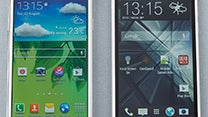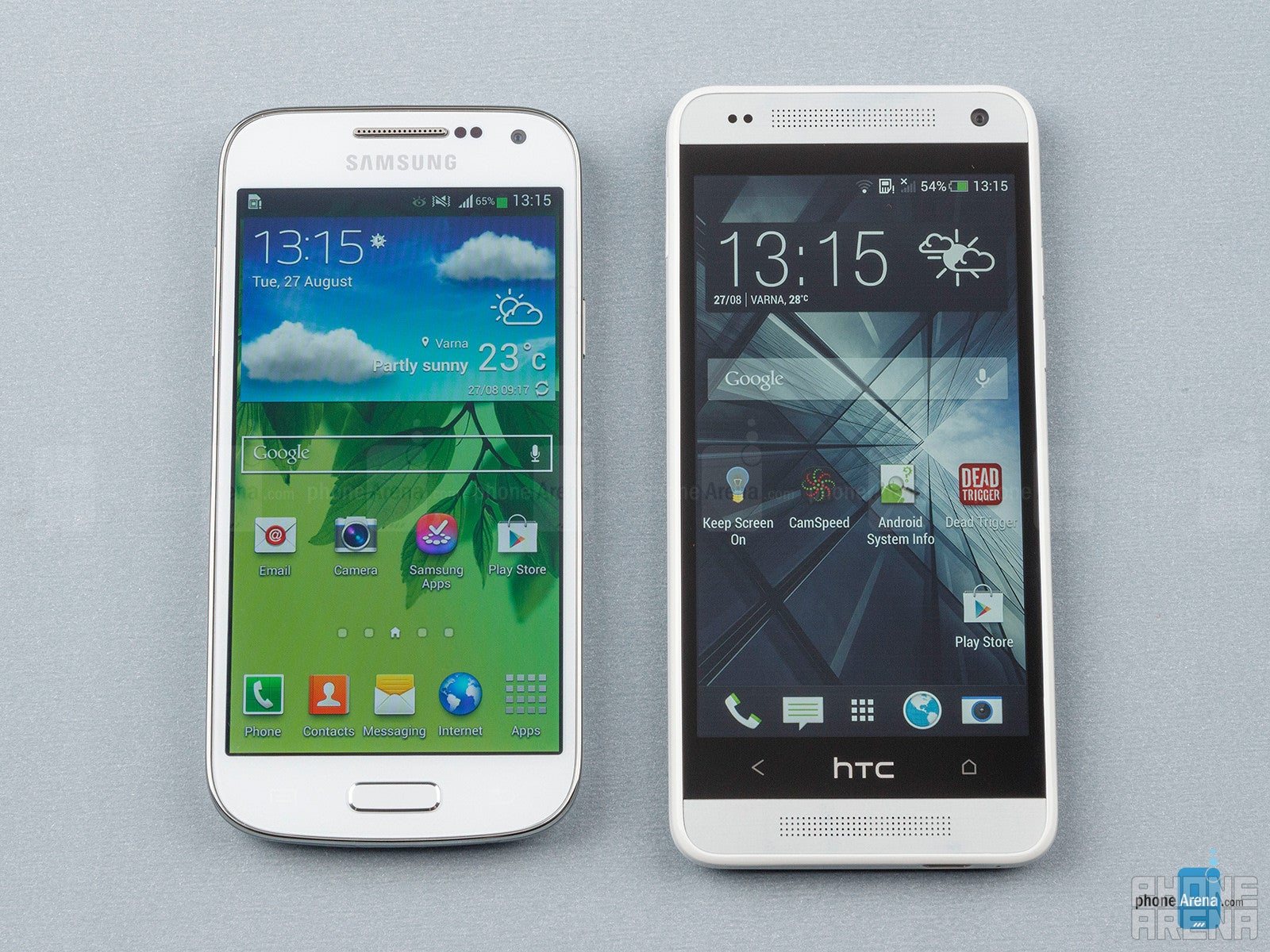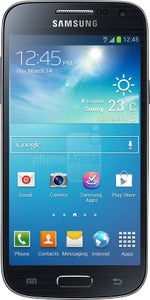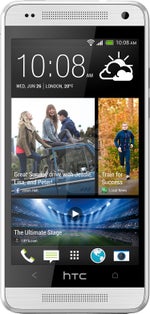Samsung Galaxy S4 mini vs HTC One mini

Introduction
In Android-land, a good smartphone is more often than not a large smartphone. Screens of 5 inches and above dominate the high-end segment, meaning that anyone who wants the very best must learn to live with a handset of not-so-pocket-friendly proportions. However, there is a handful of smartphones that pack lots and lots of bang in a small, compact package – a combo sought after by a considerable fraction of users. And right now, the Samsung Galaxy S4 mini and the HTC One mini are among the best specimens fitting the description.
On one hand, the Samsung Galaxy S4 mini and the HTC One mini seem to have a lot in common. They are both compact, easy to handle, equipped with 4.3-inch screens, and rich in terms of features. That makes ranking one of them above the other rather tricky. But the more we play with these two minis, the more differences between them we can list. In fact, we can pretty much give you a clear picture as to which smartphone you'd be more satisfied with, depending on your needs and preferences. Read on to learn more.
Design
We can't deny it: the HTC One mini is the better-looking handset among the two. It isn't leading by miles, but we'd still give it our beauty award any day as we're quite fond of its seamless unibody construction and premium metallic design. As for the plastic-made Samsung Galaxy S4 mini, it definitely catches the eye, but it simply lacks the One mini's character.
Both smartphones are narrow enough to be used very comfortably with a single hand. However, the Galaxy S4 mini is a little bit easier to handle – it isn't as tall as the HTC One mini and its screen is positioned closer to the bottom edge. In other words, the furthest side of the S4 mini's screen is closer to the user's thumb, which makes it easier to reach.
Display
That the HTC One mini has the better screen is as clear as day. While both displays have the same area and share a diagonal size of 4.3 inches, the HTC One mini's panel delivers much higher resolution and pixel density – 720 by 1280 pixels vs 540 by 960 pixels for the Samsung Galaxy S4 mini. And the difference is easy to notice when the two smartphones are put side by side. Anything from text in web pages to the pictures in the image gallery is sharper, more detailed, and easier to make out on the HTC One mini due to the higher pixel count.
Color fidelity is also better on the HTC One mini. Its Super-LCD3 screen displays very accurate hues across the entire spectrum, while the Samsung Galaxy S4 mini, packing a Super AMOLED screen, tends to boost color saturation, albeit not by much. We're also very pleased with the One mini's outdoor visibility. Its screen is brighter and reflects only a fraction of the light that hits it. The display on the Galaxy S4 mini has a low reflectance rating as well, but it isn't as bright, which makes it not as easy to see under broad daylight.
Interface
Android 4.2.2 – that's the OS of choice coming pre-installed on both the Samsung Galaxy S4 mini and the HTC One mini. But neither handset uses the platform in its stock form. Instead, the Galaxy S4 mini sports a layer of TouchWiz UI, while the One mini relies on the latest variant of Sense UI.
Picking a favorite among the two interfaces is not an easy task since they both have their advantages and peculiarities. The Samsung Galaxy S4 mini, for example, is designed to appeal to a broader audience. It has a traditional home screen arrangement, with plenty of room for icons and widgets, while the apps are listed in the app drawer. At the same time, the multitude of major and minor tweaks and features introduced with the Galaxy S4 have been ported onto the S4 mini – Group Play, S Translator, S Health, Smart Pause, to name a few. Overall, it is nice knowing that the smartphone is loaded with goodies, but whether a typical user would ever need or notice them is a whole different story.
The modifications introduced with the HTC One mini, are slightly more radical. Therefore, they might not appeal to experienced Android users who are used to the system's default look and feel, although the company's UI implementation can actually be pretty practical. BlinkFeed is the default home screen, displaying a curated list of news and articles from a variety of internet sources, along with activity from social networks the user is logged into. The goal of this is to bring all information that matters to the user within a tap's distance – perfect for active social networking users and people who like to be constantly in the know. Traditional home screens, with icons and widgets, are available as well and are accessed with a swipe. Overall, the entire UI is simple, streamlined, polished, and easy to get the hang of. For more in-depth details, our HTC One review is where you need to go to.
The two smartphones come with on-screen keyboards that are of nearly identical width and height. That's why your input rate would depend solely on how used your thumbs are to the layouts of their virtual keys, regardless of whether you're a fan of two-thumb or single-finger typing. Personally, it didn't take us long to get comfortable with either of them. The keyboards are definitely responsive enough to keep up with our fast fingers.
Processor & Memory
Even though both smartphones have the same dual-core Snapdragon 400 SoC handling all computations, the Samsung Galaxy S4 mini can provide slightly more raw processing power. That's because its CPU can sprint at up to 1.7GHz, while the HTC One mini has its processor cores capped lower, at 1.4GHz. Moreover, Samsung's handset packs 1.5GB of RAM while there's only 1 gig for the One mini. Having all that in mind, one might assume that the Samsung Galaxy S4 mini feels faster and more responsive while being used. But in reality, we can't see much of a performance difference between the two. In fact, the S4 mini might start dropping frames if its homescreens are loaded with more widgets and shortcuts than needed, while the One mini retains its smoothness at all times.
In heavy 3D gaming scenarios, however, the Galaxy S4 mini has the upper hand not only because of the higher clock speed, but due to the lower resolution of its screen. As a result, there are less pixels that need to be driven, which produces higher frame rates. Nevertheless, rest assured that even the latest, most intense 3D titles would run just fine on both handsets.
| Quadrant Standard | AnTuTu | GLBenchmark 2.5 (Egypt HD) | Vellamo (HTML5 / Metal) | |
| Samsung Galaxy S4 mini | 6783 | 13341 | 3762 / 33fps | 2088 / 685 |
| HTC One mini | 5885 | 11363 | 2714 / 24 fps | 2268 / 611 |
Unfortunately, the HTC One mini does not offer the option for expandable storage via microSD cards. Therefore, you'll be stuck with its 16GB of internal storage space, out of which about 11GB are available for use. That's not a measly amount by any means, but it will surely run out fast for those who like to carry around photos, music, and other media on their device. The Samsung Galaxy S4 mini does have just 8GB of built-in storage, less than half of which is user-accessible, but its microSD card slot can accommodate cards of up to 64GB in size. As a side note, both smartphones come bundled with free premium Dropbox subscriptions for 2 years, which is pretty cool.
Internet & Connectivity
The Samsung Galaxy S4 mini comes with a very fast web browser. So does the HTC One mini. That is why responsiveness isn't an issue no matter which of the two you choose to roam the interwebs with. But the One mini has the advantage of having a higher-res screen. As a result, small text in pages is sharper and easier to read. A potentially handy feature found on HTC's mini and not on the S4 mini is Adobe Flash support. However, the plug-in doesn't work perfectly on all web pages, at least in the HTC One mini's case, which explains why it is turned off by default.
When it comes to connectivity, the Samsung Galaxy S4 mini is one step ahead of the HTC One mini. While both handsets are available in LTE or HSPA+ variants, depending on the market, the S4 mini is offered in dual-SIM configuration as well, allowing one to use the services of two carriers simultaneously. In addition, the Samsung Galaxy S4 mini has NFC and a built-in IR beamer, allowing the user to take over their TV or home entertainment system. The HTC One mini has neither NFC support, nor any IR communication capabilities. Naturally, Wi-Fi, Bluetooth, and GPS are present on both smartphones, along with an FM radio.
Camera
Samsung has taken a conventional approach by equipping an 8MP auto-focus camera on the Galaxy S4 mini, along with a single LED flash. The HTC One mini, however, has a camera with only 4MP of resolution in native 16:9 ratio, but the sensor itself, being of the “Ultrapixel” variety, is made of much larger pixels. Theoretically, that should boost the camera's low-light performance, even though the level of detail captured in each frame might be reduced.
In reality, both smartphones take photos of similar quality, but before we get to that part, let's take a look at their camera UIs. To be honest, we're much happier with Samsung's camera interface. Settings, filters, and image adjustments are easy to get to, and switching between camera modes requires only a couple of taps. Naturally, goodies like Burst Shot, Night Shot, and HDR mode are present as well. The HTC One mini has adopted the somewhat frustrating camera UI found on its larger sibling. What we don't like about it is how all settings and adjustments are listed in a single menu with multiple sub-menus that you have to scroll through until you get to the item you're searching for. A simpler, better-organized solution would have made much more sense. That aside, the HTC One mini also offers HDR and Night modes, along with a cool slow-motion setting while shooting videos.
So as we already said, daytime photos produced with these two smartphones turn out equally good and have the same neutral color balance. The Samsung Galaxy S4 mini has the advantage of packing more megapixels, which is why its photos are more detailed when you zoom in. But the HTC One mini has a wider field of view so it can capture a wider frame from the same distance. Both cameras launch fast, focus quickly, and exhibit zero shutter lag, which is of utmost importance for capturing events as they happen. Shooting indoors yields unimpressive results. The HTC One mini's photos lack detail, while the S4 mini often fails to set the right color balance.
Both smartphones are capable of recording high-quality video at 1080p resolution, but the Samsung Galaxy S4 mini is slightly better at it than the HTC One mini. As our samples demonstrate, the former's daytime footage is more detailed and its low-light videos are much smoother.
Multimedia
Google's Play Music app comes loaded on both the HTC One mini and the Samsung Galaxy S4 mini, providing access to whatever music you have uploaded onto the cloud or purchased through the app. Alternatively, Samsung and HTC have loaded their own music player apps onto their devices. For the most part, these applications have a very similar feature set and to tell you the truth, both get their job done just fine. The mandatory lock screen controls are present as well, alongside a rich selection of enhancements – Beats Audio, SoundHound integration, and visualizer for the HTC One mini and the SoundAlive equalizer, bass booster, and Adapt Sound for the Samsung Galaxy S4 mini.
The HTC One mini has the upper hand when it comes to watching videos. It has much broader support across many popular file formats, a higher-res screen producing more detail, and a set of outstanding front-facing stereo speakers. The Samsung Galaxy S4 mini doesn't support QuickTime or DivX videos, but it does come with the pop-up play feature, allowing video to be played back in a window hovering above the UI.
Call Quality

Battery Life
It might seem counter-intuitive, but the HTC One mini's 1800mAh internal battery lasts longer on a single charge despite being a tad smaller than the S4 mini's 1900mAh replaceable cell. The former is rated for over 13 hours of talk time on 3G or 28.8 days in stand-by, while the latter is rated for about 12 hours of 3G talk time an just about 12 days on stand-by. In addition, our own battery benchmarks indicate that the HTC One mini lasts 13% longer than the Samsung Galaxy S4 mini. Nevertheless, a typical user should expect at least a full day's worth of usage from either handset.
Conclusion
Both Samsung and HTC have crafted excellent “mini” versions of their current flagships, unifying premium user experience with compact form factor. But each of these two Android smartphones excels in its own way, as our thorough examination goes to show. The Samsung Galaxy S4 mini, for example, is smaller, lighter, and easier to handle. It is also equipped with a better camera and a microSD slot for storage expansion. The HTC One mini, on the other hand, is a smartphone that would attract many with its outstanding design. On top of that, it comes with a much better screen and a great set of stereo speakers, which makes it ideal for entertainment and multimedia consumption. So all in all, its a tie and we can't elect a clear winner between the two. Both can serve as an example as to how a good mid-range Android smartphone should be made, so regardless of which you pick, chances are you won't be disappointed.
















Things that are NOT allowed: